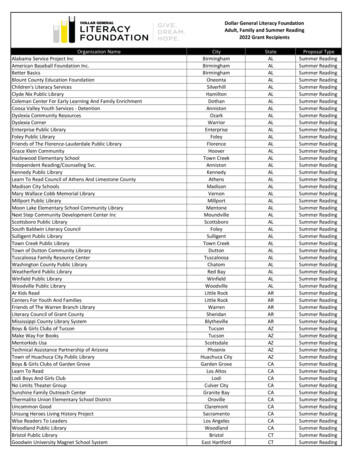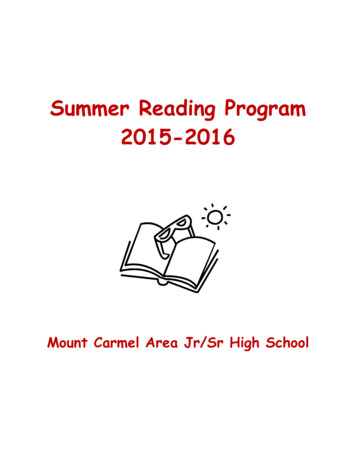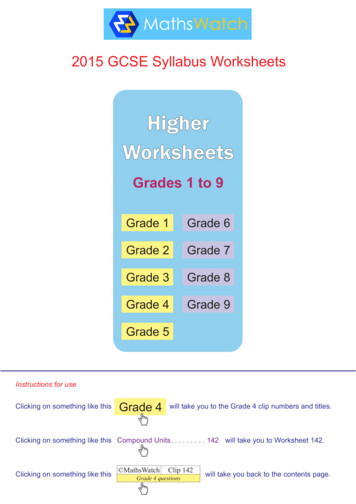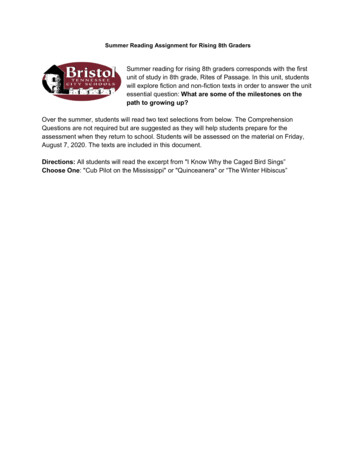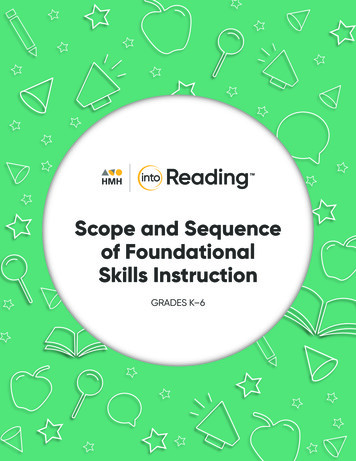
Transcription
rReadingStudentPacketSummer2015
2THE7HABITSOFHIGHLYEFFECTIVETEENSSUMMER READING REQUIREMENTS 2015We are pleased to provide you with the information for the 2015Summer Reading Program. This program is a requirement for ALLstudents entering grades 6-12.Why should everyone make summer reading a top priority?Without addressing what happens to students educationally over the course of the summer, it’simpossible to close the academic achievement gap. No matter how much high-quality learningtakes place over the school year, many children will still fall behind during the summer unlessthey are given the attention and resources that they will need to continue learning during thesepivotal months.As we prepare our students for the skills that they will need to be successful in the 21st Century, itis imperative that we provide activities/opportunities that keep students both engaged, as well as,help to build their literacy skill set.Having access to books and other educational resources during the summer months reinforcesgood learning habits and is critical to improving and/or maintaining the student’s academicsuccess. Those who lack the opportunity to read, write, think and participate in book discussions,will continue to fall behind every summer; consequently, making the achievement gap too greatto close.Did you know that summer reading could improve: Reading and Writing Proficiencies Building of Vocabulary skills Development of Grammar Increase Test Scores Enjoyment of Reading
All of these fundamentals are vital for students to be considered to be college bound and careerready.Summer Reading RequirementsEach student is required to read ONE book over the summer as outlined below. This required text,is relevant and beneficial to making connections with the curriculum. It serves as an anchor textto which both teachers and students can utilize as a resource; in order to, analyze, provide depth,and understanding for various types of class discussions throughout the year. This commonentry point for the fall will support a positive classroom literacy community beginning from thefirst day of school.Dialectical JournalingThe term “Dialectic” is defined as, “The art or practice of arriving at the truth by usingconversation involving question and answer.” Think of your dialectical journal as a series ofconversations within the text you are reading over the summer. The process is meant to help youdevelop a better understanding of the text while reading. Use your journal to incorporate yourpersonal responses to the text. This can include your ideas and thoughts about the theme(s),tone and purpose of the text. This strategy is a useful way to process what you’re reading,prepare for class/group discussion, and gather textual evidence for your Literary Analysisassignments. The procedures for maintaining your dialectical journal are attached; therefore, it ispertinent to follow this process thoroughly.GradingStudents are expected to participate in class discussions and submit their dialectical journalsthat revolve around the required reading, during the first two (2) weeks of school. All summerreading assignments will be incorporated into the student’s first quarter grade and is worth avalue of 10 points.
4THE7HABITSOFHIGHLYEFFECTIVETEENSWhere do I get the books?The easiest ways to obtain the books specified are to borrow them from either the school or locallibrary. It is imperative that you secure your copy as soon as possible before it becomesunavailable.You may choose to purchase your books. To help with this option, we have enlisted the supportof Barnes & Noble. They will have access to the district’s required reading list, as well as, providedisplays to help you find the book that you need. When you finish reading a book, we ask you toconsider sharing that book with another student that you know. This will allow more access forall.Audio and eBooksIf available, books are available in different formats (eBook, audiobook) at Barnes and Nobles inLivingston, Clifton and Springfield. Each store has access to the required reading and task.Let’s ReviewTo make this process simple, just remember this formula:1 book 1 writing task dialectical journal SUMMER READINGSUCCESS!!Do your best so that you can start off the year successfully. All handouts as well as examples areavailable from the summer reading link on the district’s home page.
Summer Reading ProjectGrade 12: Summer 2015College & Career Readiness Anchor Standards:Reading – CCRA.R1, CCRA.R2, CCRA.R3, CCRA.R4, CCRA.R5, CCRA.R6, CCRA.R8,CCRA.R.10Writing – CCRA.W1, CCRA.W2, CCRA.W4, CCRA.W5, CCRA.W6, CCRA.W7,CCRA.W8, CCRA.W9, CCRA.W10All incoming 10th grade students are required to read the “The 7 Habits of HighlyEffective Teens” by Sean Covey. The author provides a step-by-step guide to helpteens improve self-image, build friendships, resist peer pressure, achieve their goals,get along with their parents, and much more.This packet consists of various performance tasks that allow students to demonstratean understanding of the specified tasks and standards. Students are expected tocomplete the performance tasks and submit entries into their dialectical journalconsisting of their thoughts and ideas while reading and then hand in bothcompleted assignments to their English II teacher within the first two (2) weeks ofschool.WEEKS 1 & 2 (JULY 6-10 & 13-17) ACTIVITY 1: Habits and YouHabits are things we do repeatedly. However, most of the time we are hardly awarethat we have them; they’re generally on autopilot. Some habits are good such asexercising regularly; whereas, others are not so good, like smoking and blamingothers for our shortcomings. Additionally, there are other habits that have no realeffect on our lives, such as, taking a shower in the evening verses the morning.In your journal, create a list of all your GOOD and BAD habits. Be honest and don’thold back on your thoughts. Next to the “BAD” habits, identify strategies that you’veattempted to modify or eliminate.Example:Good Habits1. Getting proper sleep2. Snacking on healthy foodsBad Habits1. Blaming others2. Texting while drivingModify/Eliminate1. Taking responsibility2. Silencing phone
6THE7HABITSOFHIGHLYEFFECTIVETEENSWeeks 1 & 2 – WRITING PROMPTIn the introduction of “The 7 Habits of Highly Effective Teens”, Sean Covey explains hismotivation and purpose for writing the book. He states, “ life for a teenager is nolonger a playground.I’ll give you a set of tools (or habits) to help you deal with reallife.”What are some habits that help you do well in school? Are there new habits thatwould help you to perform a better job at school? What are they? Explain yourthinking.WEEKS 3 & 4 (JULY 20-24 & 27-31) ACTIVITY 2: Choose How to Respond“Reactive people make choices based on impulse. They are like a can of soda pop.If life shakes them up a bit, the pressure builds and they suddenly explode”, (Covey,1998, p. 49).“Proactive people make choices based on values. They think before they act. Theyrecognize they can’t control everything that happens to them, but they can controlwhat they do about it. Unlike reactive people who are full of carbonation, proactivepeople are like water. Shake them up all you want, take off the lid, and nothing? Nofizzing, no bubbling, no pressure. They are calm, cool, and in control” (Covey, 1998,pg. 49)How do you react when someone cuts in front of you in line? Do you yell at thatindividual, or just let it go? If you get in an argument with your best friend, do you tellthem off and avoid them for months, or do you forgive her? We get the opportunity tochoose how we respond to different situations about 100 times a day. .The chart below contains reactive statements. Next to each reactive statement, writea corresponding proactive statement. Record in your journal.PROACTIVE LANGUAGEExample: I’ll do it.REACTIVE LANGUAGEI’ll try.That’s just the way I am.There’s nothing I can do.I have to.I can’t.
Weeks 3 & 4 – WRITING PROMPTWhat is it like being around a person who reacts like a can of shaken soda? Drawtwo cartoons to depict proactive and reactive behavior. Be prepared to share yourdrawings and describe each cartoon and the type of behavior. Record in yourjournal.WEEKS 5 & 6 (AUGUST 3-7 & 10-14) ACTIVITY 3: Think Win-WinOn page 152, Covey defines Habit 4 “Win-Win” as, “A belief that everyone can win.It’s both nice and tough all at once. I won’t step on you, but I won’t be your doormateither. You care about other people and you want them to succeed. But you alsocare about yourself, and you want to succeed as well. Win-Win is abundant. It is thebelief that there’s plenty of success to go around. It’s not either you or me. Its both ofus.”Write a short “Thank You For Being You” letter/note to a person in your life who hasbeen a model of “win-win” thinking. Use excerpts or quotes from the text to supportyour reasons that relate to this person’s character or traits. Choose one of MicrosoftWords informal letter templates as a guide to write your letter/note.Weeks 5 & 6 – WRITING PROMPTWhat type of outlook on life do you have now (Win-Lose, Lose-Win, Lose-Lose)? Whydo you think you struggle with thinking win-win? Are there specific situations thatcause you to think Lose-Win, Win-Lose, or Lose-Lose? How has your previous attitudeaffected your life? Record in your journal.DIALECTICAL JOURNALINGThe term “Dialectic” is defined as, “The art or practice of arriving at the truth by usingconversation involving question and answer.” Think of your dialectical journal as aseries of conversations with the text while reading. The process is meant to help youdevelop a better understanding of the text you read. Use your journal to incorporateyour personal responses to the text and your ideas about the theme of the text. Youwill find that it is a useful way to process what you’re reading, prepare yourself forgroup discussion, and gather textual evidence from the reading.DIALETICAL JOURNALING PROCEDURE:1) As you read, choose passages that stand out to you and record them in theleft-hand column of the chart (ALWAYS include page numbers).2) In the right column, write your response to the text (ideas/insights, questions,reflections, and comments on each passage)3) You must label your responses using the following codes:
8THE7HABITSOFHIGHLYEFFECTIVETEENS(Q) Question – ask about something in the passage that is unclear(C) Connect – make a connection to your life, the world, or another text(P) Predict – anticipate what will occur based on what’s in the passage(CL) Clarify – answer earlier questions or confirm/disaffirm a prediction(R) Reflect – think deeply about what the passage means in a broadsense–not just to the characters in the story/author of the article. Whatconclusions can you draw about the world, about human nature, or justthe way things work? (E) Evaluate - make a judgment about what the author is trying to say Sample Dialectical Journal entry: Going Beyond the Yellow HighlighterPassages from thetext. Must quote atleast 3-5 per readingchapter. Make sure tonumber them.Page#/¶EACH passage you quote or respond to must relateto one of the following codes above. Make sure touse a variety. Using the same codes for most or allof your entries will result in a lower score.1. "The yellow marks inmy college textbooks.didnot help me very much.”82/12. "Annotations do makeme read a lot slower andI wish I didn't have to dothem. It is so muchharder to fake read ifyou have to annotate likewe have to do now. Sonow I actually read,because it's too hard tofake annotate".87/2(C) I can relate since I often used to highlight what Ithought was important and then end up with most of thepage highlighted.(C) It is harder to fake annotate--it almost takes moretime.(R) People are prone to find the easy way to do something.Since there's really no easy way to annotate-fake or real-it makes sense to really read and think about the texts.(Q) Is it really harder to fake read if you have toannotate? Or does it just take longer?CHOOSING PASSAGES FROM THE TEXT:Look for quotes that seem significant, powerful, thought provoking, or puzzling. Forexample, you might record: Effective and/or creative use of literary devicesPassages that remind you of your own life or something you’ve seen before,Structural shifts or turns in the plot,A passage that makes you realize something you hadn’t seen before,Examples of patterns: recurring images, ideas, colors, symbols or motifs,Passages with confusing language or unfamiliar vocabulary,Events you find surprising or confusing,
Passages that illustrate a particular character or settingRESPONDING TO THE TEXT:You can respond to the text in a variety of ways. The most important thing toremember is that your observations should be specific and detailed. You can write asmuch as you want for each entry.Basic Responses: Raise questions about the beliefs and values implied in the text Give your personal reactions to the passage Discuss the words, ideas, or actions of the author or character(s) Tell what it reminds you of from your own experiences Write about what it makes you think or feel Agree or disagree with a character or the authorSample Sentence Starters:I really don’t understand this because.I really dislike/like this idea because.I think the author is trying to say that.This passage reminds me of a time in my life when.If I were (name of character) at this point I would.This part doesn’t make sense because.This character reminds me of (name of person) because.Higher Level Responses: Analyze the text for use of literary devices (tone, structure, style, imagery) Make connections between different characters or events in the text Make connections to a different text (or film, song, etc.) Discuss the words, ideas, or actions of the author or character(s) Consider an event or description from the perspective of a different character Analyze a passage and its relationship to the story as a whole
6!THE!7!HABITS!OF!HIGHLY!EFFECTIVE!TEENS!! Weeks 1 & 2 – WRITING PROMPT In the introduction of “The 7 Habits of Highly Effective Teens”, Sean Covey explains his motivation and purpose for writing the book. He states, “ life for a teenager is no longer a playground.I’ll give you a set of tool
